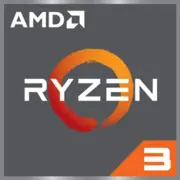AMD Ryzen 3 PRO 1200

AMD Ryzen 3 PRO 1200: Budget Processor for Basic Tasks in 2025
Updated: April 2025
1. Key Specifications: Zen Architecture and Balance for Office Tasks
The AMD Ryzen 3 PRO 1200, released in 2017, remains an accessible solution for less demanding users. Despite its age, its specifications are still relevant for basic tasks:
- Architecture: Zen (first generation).
- Manufacturing Process: 14 nm.
- Cores/Threads: 4/4.
- Base/Boost Clock: 3.1 GHz / 3.4 GHz.
- L3 Cache: 8 MB.
- TDP: 65 W.
- Performance: Geekbench 6 — 1038 (single-core), 3022 (multi-core).
Key Features:
- Support for AMD SenseMI technologies and Secure Processor for data protection.
- Low power consumption — suitable for compact PCs.
- Lack of integrated graphics — a discrete graphics card is required.
Practical Example: In 2025, the processor can be found in office computers where stability is more important than high performance. For tasks like working with office applications (Excel, Word) and browsing, it operates smoothly without delays.
2. Compatible Motherboards: AM4 Socket and Budget Chipsets
The processor uses the AM4 socket, which is supported by many motherboards. However, due to the age of the Ryzen 3 PRO 1200, it's important to consider nuances:
- Chipsets: A320, B350, X370 (the minimum cost of new boards starts from $50, for example, ASRock A320M-HDV).
- BIOS Update: Most new motherboards from 2023-2024 require a firmware update to work with first-generation Zen.
- Tip: Look for boards marked as “Ryzen 1000 Series Ready” or purchase models with the ability to update the BIOS without a CPU (USB Flashback).
Popular Options:
- Budget-Friendly: Gigabyte GA-A320M-S2H ($55–65).
- Capable of Upgrade: MSI B350M PRO-VDH ($70–80) — supports overclocking.
3. Supported Memory: DDR4 with Limitations
The Ryzen 3 PRO 1200 works with DDR4 memory, but with certain nuances:
- Maximum Frequency: 2666 MHz (without overclocking).
- Dual-Channel Mode: Essential for performance improvement. For example, two 8 GB DDR4-2400 modules can provide up to a 15% boost in gaming and rendering.
- Compatibility: It's better to use memory with low timings (CL16 or lower).
Example Configuration: Patriot Signature Line 16 GB (2×8 GB) DDR4-2400 — $35.
4. Power Supply: Minimum Requirements
With a TDP of 65 W, the processor does not require a powerful PSU:
- Minimum Power Rating: 400 W (e.g., EVGA 400 W1, $35).
- Recommendations:
- For systems without a discrete graphics card, a 300 W power supply will suffice.
- When installing a graphics card at the level of NVIDIA GTX 1650, choose a PSU rated at 450–500 W (Corsair CX450, $50).
- Tip: Don't skimp on the PSU—cheap models can damage components.
5. Pros and Cons
Pros:
- Price: New processors are still available for $70–80.
- Reliability: No critical vulnerabilities (unlike some Intel CPUs).
- Energy Efficiency: Suitable for PCs with passive cooling.
Cons:
- Outdated Architecture: Lags behind modern Ryzen 5000/7000 in IPC.
- No SMT: Only 4 threads — weak multi-tasking.
- Lack of PCIe 4.0/5.0: Limits the speed of NVMe drives.
6. Use Cases
- Office Tasks: Working with documents, video conferencing, browsing with 10+ tabs.
- Multimedia: Watching 4K videos (with hardware decoding through the graphics card).
- Light Gaming: CS2, Dota 2, GTA V on low settings (with a GPU at the level of GTX 1050 Ti).
- Server Applications: NAS or home media server due to low TDP.
Real Experience: A user on Reddit built a PC for studying using the Ryzen 3 PRO 1200 — a system with an SSD and 16 GB of RAM runs Zoom, Chrome, and LibreOffice without hiccups.
7. Comparison with Competitors
- Intel Core i3-10100 (4/8): Better multi-threading performance (Geekbench 6 Multi ~3500), but more expensive ($100–110).
- AMD Ryzen 5 1400 (4/8): Just $10–15 more, but with SMT support — wins in rendering.
- Intel Pentium Gold G7400 (2/4): Less powerful (Geekbench 6 Multi ~2200), but has integrated UHD 710 graphics.
Conclusion: The Ryzen 3 PRO 1200 is advantageous only when operating on a tight budget or for specific tasks (e.g., Linux server).
8. Practical Assembly Tips
- Motherboard: Choose models with HDMI/DVI if you're using a graphics card without modern ports.
- Cooling: The box cooler is sufficient, but for quieter operation, consider the DeepCool GAMMAXX 400 V2 ($20).
- Storage: Always use an SSD (for example, Kingston A400 240 GB — $25).
- Upgrade: Don't invest in an expensive motherboard — AM4 is becoming outdated.
9. Final Verdict: Who Should Consider the Ryzen 3 PRO 1200?
Choose this processor if:
- Your budget is limited to $200–300 for the entire build.
- You need a PC for office work, study, or servers.
- You plan to use old components (like DDR4-2400 from a previous PC).
Why Not?: For gaming, video editing, or AI-related work, there are more modern options (Ryzen 5 5500, Intel i3-12100).
Price in 2025: The new Ryzen 3 PRO 1200 is priced at $70–80, making it one of the most affordable 4-core solutions. However, due to its moral obsolescence, it's better to consider it a temporary solution.
If you are building a PC for "a couple of years" or want to revive an old case — the Ryzen 3 PRO 1200 still has a place. But for long-term use, look for processors with DDR5 and PCIe 5.0 support.
Basic
CPU Specifications
Memory Specifications
GPU Specifications
Miscellaneous
Benchmarks
Compared to Other CPU
Share in social media
Or Link To Us
<a href="https://cputronic.com/cpu/amd-ryzen-3-pro-1200" target="_blank">AMD Ryzen 3 PRO 1200</a>